

Over the past few decades, research into platelet-rich plasma (PRP) has led to an innovative treatment that uses your blood to promote healing in tendons, ligaments and other tissues. PRP injections are a modern solution to help people recover from surgery, injuries and disease faster with fewer medications.
PRP injections aren’t just for professional athletes. They’re a mainstream treatment that can benefit anyone. While many people have heard about PRP injections in the media, few know about their unique benefits. This guide will explain everything you need to know about PRP injections and whether they’re the right treatment option for you.
Platelet-rich plasma (PRP) is a substance derived from blood containing natural growth factors that can help your body heal its tissue. Blood consists of plasma, red cells, white cells and platelets. Platelets create blood clots and contain growth factors that play a significant role in the natural healing process. Doctors will draw a blood sample from the patient and use a machine to separate the platelets until it’s three to five times more concentrated with growth factor.
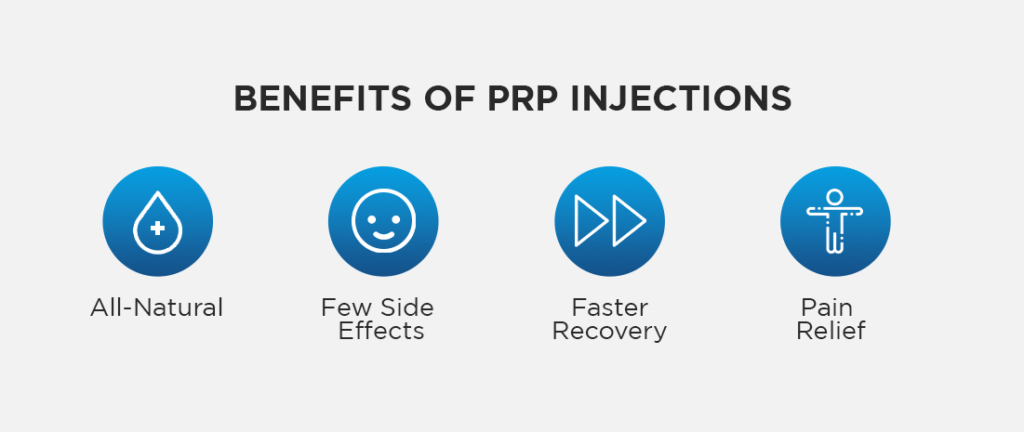
Platelet-rich plasma (PRP) injections are created from a sample of the patient’s blood to treat damaged ligaments, tendons, muscles or joints. A doctor injects PRP into the injured tissue to speed the healing process and reduce pain. The injections help your body grow new healthy cells in a natural way that utilizes your body’s healing process. Doctors could potentially use PRP injections to treat some musculoskeletal problems with fewer opioids and other harsh medications.
As PRP increases in popularity, researchers are still exploring the full benefits of PRP treatments. Here are some benefits of PRP injections that doctors and patients have identified so far.
PRP treatments are entirely natural and comprised of cells from your body. The injection doesn’t require anesthesia and has minimal recovery time.
PRP is derived from your own blood, which eliminates the risk of having an adverse reaction to the injection. Other than pain at the injection site, complications or side effects from PRP are incredibly uncommon. There is less than a 1% chance of developing a local infection. You’re at a much lower risk of side effects with PRP than if you choose other alternatives, like opioids, cortisone injections and surgery.
The platelets in your blood contain growth factors that promote the repair and regeneration of tissues in your body. PRP injections harness the power of growth factors and deliver it to your injured tissues to help speed up your body’s natural healing process. PRP accelerates recovery so you can return to an active lifestyle with less pain and an increased range of motion.
PRP injections have provided significant pain relief for some injuries and health conditions. This treatment relieves pain at the source by healing the underlying injury or disease. PRP injections can help patients achieve long-term pain relief as their healing progresses.
The process of getting PRP injections is relatively simple. Here’s what you can expect:
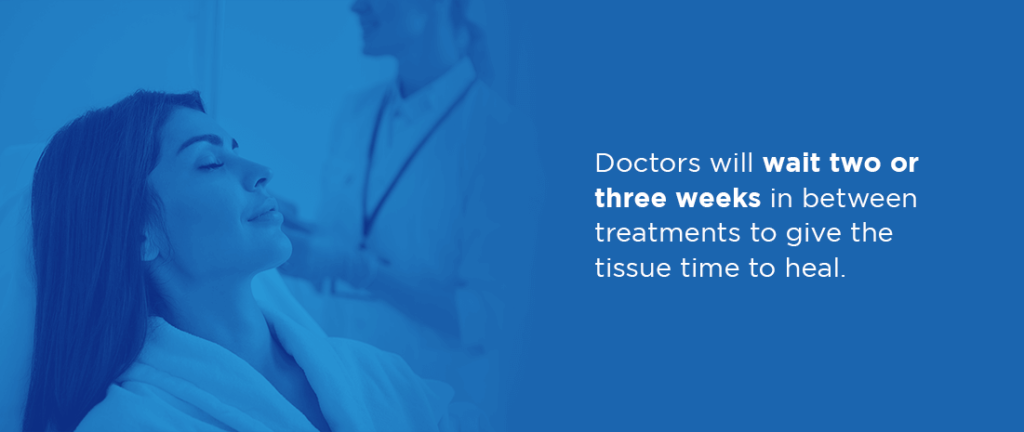
You may need up to three injections, depending on your condition. Doctors will wait two or three weeks in between treatments to give the tissue time to heal.
PRP is used to speed the healing process for patients with musculoskeletal disorders. Doctors administer PRP in different ways depending on the injury:
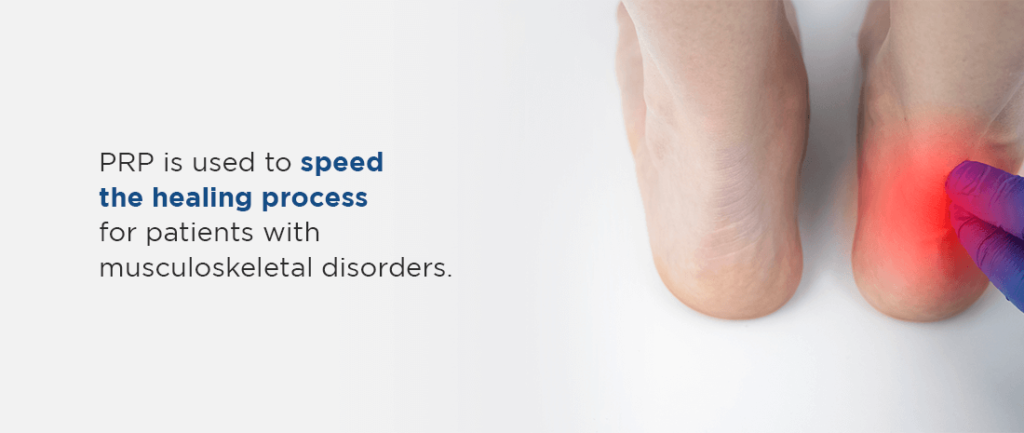
PRP is mainly used to treat tendons, ligaments, bones and soft tissues. However, researchers are starting to use PRP for cosmetic applications as well. Physicians use PRP injections to treat the following conditions.
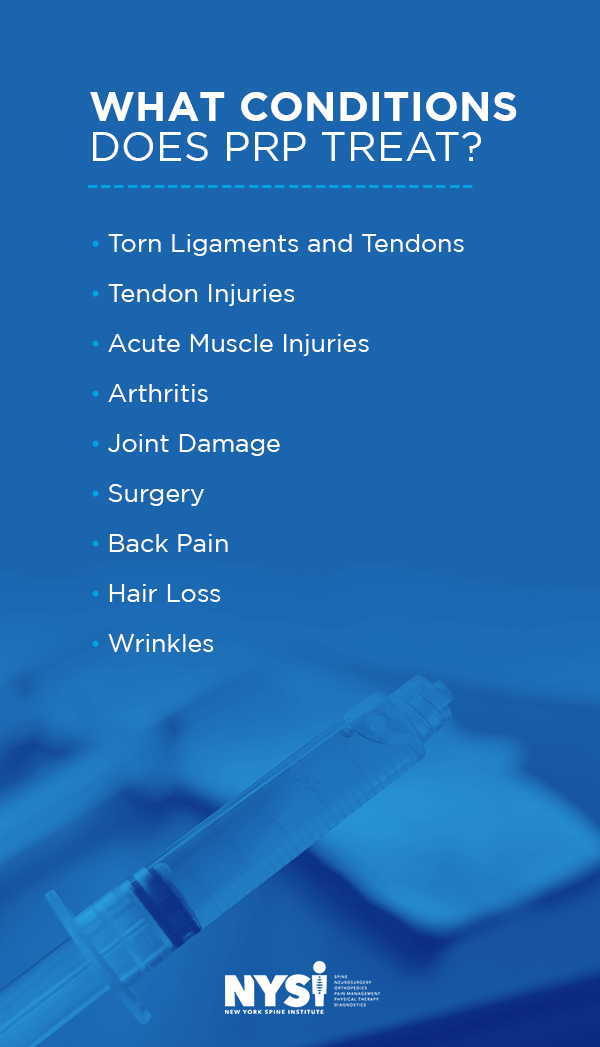
Worn-out ligaments and tendons are prone to tearing from excessive use or contact sports. Approximately 16.4 million Americans injure a ligament or tendon each year. The lack of blood flow to some ligaments and tendons can prolong recovery from this type of injury. Existing treatments only partially heal the tissues, increasing the risk of re-injury in the future.
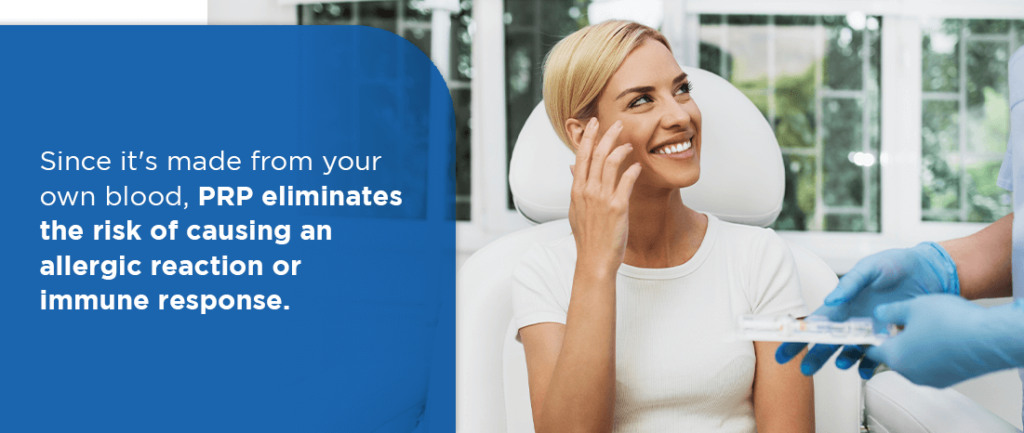
PRP injections supply the injured tissues with a boost of growth factors to potentially improve healing and reduce recovery time. They help strengthen and regenerate damaged tissues to heal your ligaments and tendons to their original function.
Tendons are located all over the body to connect the muscles to the bone. Gradual wear and tear from playing sports or working out can lead to tendon injuries. When a tendon is overused, it becomes inflamed, causing pain and stiffness during movement. Tennis elbow, jumper’s knee and Achilles tendinitis are common injuries that PRP can help treat. PRP injections could potentially speed the healing process and reduce pain so you can return to an active lifestyle sooner.
When an athlete pulls a hamstring or sprains their knee, they face months of recovery time. PRP treatments can help accelerate the healing process for acute injuries to help you return to play sooner, whether you’re a professional athlete or weekend runner.
Research has found that PRP injections are an effective treatment for knee osteoarthritis. Patients reported a higher pain reduction from PRP injections compared to hyaluronic acid treatments. Studies also show positive results from using PRP to treat rheumatoid arthritis. PRP injections help reduce inflammation that causes pain and loss of movement so that people with arthritis can lead more active lifestyles. More research is necessary to determine the full benefits of using PRP injections to treat these and other types of arthritis.
You use your joints for every movement you make. Over time, your joints can become worn out and overworked. As you age, joint disease and injuries become more prevalent. Nearly one in four adults with arthritis report dealing with severe joint pain. Doctors can use PRP injections to help relieve symptoms of joint pain from arthritis, bursitis, injuries and other conditions.
These injections help rebuild damaged tissue, stimulate joint lubrication and reduce inflammation to alleviate pain and stiffness. Patients who receive PRP treatment could potentially experience less discomfort and greater mobility in their joints.
PRP is often used in musculoskeletal surgeries to help heal ligaments, tendons and other tissues. Recently, doctors have started using PRP to prevent infection following cardiac operations. The risk of developing an infectious complication from cardiac surgery is high and can lead to prolonged recovery, higher costs and death.
PRP injections help accelerate the healing process to lower the risk of developing an infection. With PRP, doctors can reduce the risk of deep sternal wound infections from 2% to 0.6% and superficial sternal wound infections from 8% to 2%. Using PRP also reduces the costs associated with infectious complications from over $1.2 million to less than $600,000. PRP injections can significantly improve the recovery outcomes for all patients that undergo cardiac surgeries.
In recent years, doctors have turned to PRP injections to treat chronic back pain and spinal conditions. Degenerative disc disease is a common condition that affects 40% of people over age 40. It occurs when one or more intervertebral discs are damaged. When discs are dislocated or torn, it can lead to swelling and discomfort in the surrounding area.
Surgery, medications and physical therapy can reduce symptoms but often fail to treat the underlying condition. PRP can help heal degenerative disc disease and other damaged tissues by treating pain and loss of mobility at the source. Rather than masking the symptoms of degenerative disc disease, PRP injections help close up any tears and strengthen the surrounding tissues to improve your spinal health.
Over the past decade, PRP has risen in popularity as a treatment for androgenetic alopecia (AGA). AGA is a common hair loss disorder that impacts 45% of men and 35% of women over age 60. Genetic and hormonal factors cause the hairline to thin in a defined pattern.
Current therapies for AGA provide varying improvements, and some people are unsatisfied with the results. In theory, injecting PRP into your hair follicles will stimulate the cells responsible for hair growth. People are turning to PRP injections because they’re less invasive, all-natural, have fewer side effects and are more affordable. Research suggests that routine PRP treatments can increase hair density by over 50%.
The “vampire facial” has received a lot of attention in the media for providing younger-looking skin. As you may guess, this procedure gets its unique name from the PRP derived from the patient’s blood. A dermatologist injects small amounts of PRP into the skin with a syringe or microneedling device. Following this procedure, some patients report having fewer wrinkles, plumper skin, reduced acne scars and a brighter complexion.
Since this treatment is in the early stages of development, more research is needed to understand the full potential of PRP injections for dermatology.
PRP injections show promising benefits for many different conditions. If you’re considering PRP treatments, we’ve answered some of the most common questions to help you make an informed decision.
PRP injections are autologous, which means the cells used for the treatment are from the same individual. The autologous preparation of PRP means they’re inherently safe and free of transmittable disease. Since it’s made from your own blood, PRP eliminates the risk of causing an allergic reaction or immune response.
You receive PRP treatments through injection, which raises concern over infection and vein damage. However, these side effects rarely occur. The possibility of getting an infection from a PRP infection is less than 1%. PRP actually inhibits bacterial growth to help prevent infections after surgery. The most common side effect is soreness near the injection as your body starts healing, which should diminish within a few days.
Several studies have found that PRP injections can be successful at treating certain musculoskeletal conditions. They show potential for treating injured tendons and arthritis. However, more research is necessary to determine the full spectrum of disorders that PRP injections can improve. Some factors that can influence the success of PRP injections include:
PRP injections require minimal preparation. Your doctor may suggest that you stop taking certain medications and supplements a week before your procedure. Nonsteroidal anti-inflammatory drugs like ibuprofen, naproxen and aspirin suppress the effects of growth factors in your blood, rendering the PRP treatment useless. Some herbs and supplements cause blood thinning, which could also reduce the quality of your blood sample.
If you take systematic steroids or receive steroid injections, you’ll have to create a plan with your doctor to stop taking these medications at least a month before your procedure. Stopping suddenly on your own could cause dangerous side effects.
Eat a nutritious breakfast and drink plenty of water on the day of your procedure, so you’re prepared to give a blood sample.
The initial blood draw and PRP injection cause various levels of discomfort depending on your pain tolerance and other factors. A needle delivers PRP treatments through the skin into the targeted area. The discomfort level depends on the location of the injection. Joint injections typically cause minimal irritation. Doctors may use a local anesthetic like epinephrine to numb the area without interfering with the PRP. Many patients find that the pain of PRP injections is worth it for the benefits they provide.
PRP injections are long-lasting, but they’re not permanent. Everyone experiences a different degree of healing based on their unique situation.
Studies show that PRP treatments for tendon and ligament injuries and arthritis can last 12 months or more after the first injection. The effects of one PRP treatment last up to 16 months for hair loss and 18 months for skincare. Research is still being conducted to gather even more accurate estimates.
You can help extend the effects of a PRP treatment by taking care of your body. Eating a healthy diet and staying hydrated will boost your immunity and increase circulation to fuel the healing process. Following your doctor’s orders after treatment is vital to the success of your injection. Getting routine maintenance shots will also extend the life of your PRP treatment.
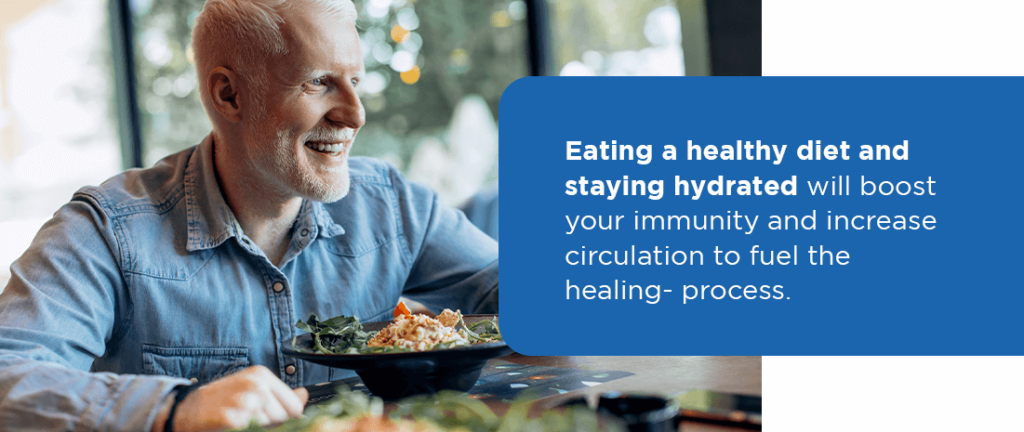
The main factors that determine how long your PRP treatment will last are:
The PRP treatment is minimally invasive with a short recovery time. Following the injection, you’ll rest in the exam room for 15 to 30 minutes before being discharged home. Mild redness, swelling and discomfort are expected within a few days of treatment.
Notify your medical care provider if the pain becomes intense. About one in 10 patients experience a post-injection flare that can cause significant discomfort and swelling. Doctors may prescribe pain medication to provide some relief.
If you experience progressive swelling, redness or fever, you should contact your physician in case of infection. Although rare, infections can occur and require antibiotics.
For 24 to 48 hours after treatment, you should limit your movements to basic daily activities only. Doctors may recommend crutches for one or two days if your injury is in a weight-bearing location.
Avoid using heat or ice on the treatment area unless advised to do so by your doctor. You may shower normally, as long as you replace the bandage to keep the injection site clean and dry.
Only take medications that your doctor approves. Don’t take any nonsteroidal anti-inflammatory drugs like aspirin, naproxen or ibuprofen that will prevent your treatment from working.
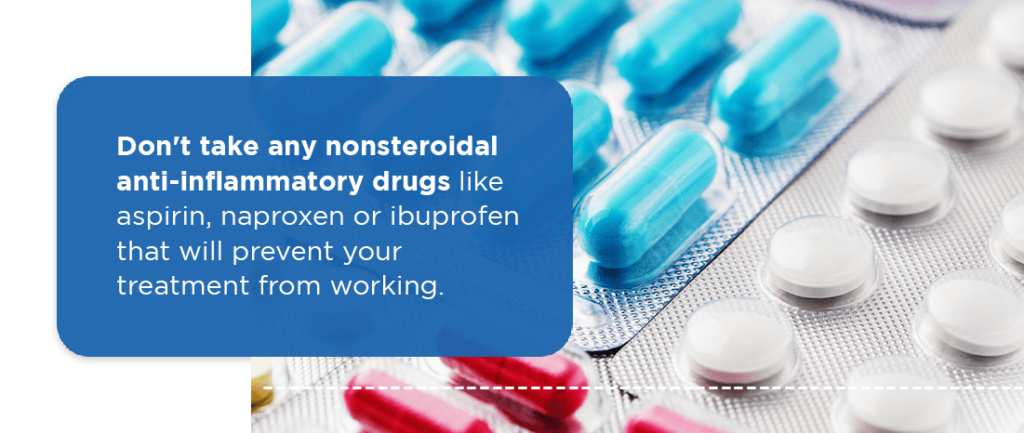
You should avoid strenuous activities for several weeks following your procedure. Wait for your doctor’s permission before returning to sports or exercising.
While PRP injections accelerate the healing of your wound, it may take several weeks before you experience results. Most people notice relief within four to six weeks of their first injection. Mild conditions will respond to treatment faster than serious injuries or chronic diseases. For some applications, it may take months before you notice a difference. If you need multiple injections, you’ll likely see more improvements with each treatment.
The exact price of a PRP treatment will vary based on many factors, including your insurance coverage, treatment provider, the extent of your injury and the number of injections you need. The price of a PRP treatment is estimated at $500 to $1,200 per injection. One injection is sufficient for some patients, while others may need three or more.
Contact your insurance company to find out if you have full or partial coverage for this procedure. Because PRP injections are considered experimental, you may have to pay out of pocket. Your treatment provider will give you a more accurate estimate of the cost before the procedure.
Whether you’re struggling with chronic back pain or torn ligaments in your knee, we can help you manage musculoskeletal disorders throughout your entire body. At New York Spine Institute (NYSI)= our orthopedic doctors will help you find cutting-edge treatment for chronic pain, orthopedic conditions and complex spinal disorders. We offer PRP injections and other innovative medical solutions for a wide range of injuries and diseases.
We provide a full range of treatments for the following categories of care:
We’ll assess your condition and recommend the best course of action. Request an appointment today to discover your treatment options with our Orthopedics & Sports Medicine doctors.